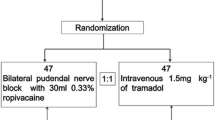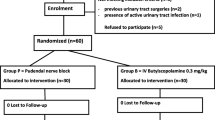Abstract
Introduction and hypothesis
The aim of this study was to investigate the impact of retropubic injection of 0.125% bupivacaine during midurethral sling placement on postoperative pain.
Methods
A randomized, double-blind trial of 42 women undergoing midurethral sling for stress incontinence was conducted. The intervention group received an injection of 0.125% bupivacaine in the retropubic space prior to midurethral sling placement, while the control group received no injection. Pain scores were recorded via a 10-cm visual analog scale at 2, 6, and 24 h postoperatively.
Results
Pain scores were lower in the bupivacaine group compared to the control group at 2 h (1.9 versus 2.6, p = 0.05). Mean pain scores were similar at all other time points (all p > 0.45). Participants in both groups used similar amounts of pain medication in the hospital, except that patients in the bupivacaine group used more PO non-steroidal anti-inflammatory drugs (p = 0.047).
Conclusions
Retropubic injection of 0.125% bupivacaine at the time of midurethral sling placement decreases short-term postoperative pain.

Similar content being viewed by others
Abbreviations
- SPARC:
-
Suprapubic arc
- UNC:
-
University of North Carolina
- NSAIDs:
-
Non-steroidal anti-inflammatory drugs
- VAS:
-
Visual analog scale
References
Abrams P, Cardozo L, Fall M et al (2003) The standardisation of terminology in lower urinary tract function: report from the Standardisation Sub-committee of the International Continence Society. Urology 61(1):37–49
Nygaard I, Barber MD, Burgio KL et al (2008) Prevalence of symptomatic pelvic floor disorders in US women. JAMA 300(11):1311–1316
Kane AR, Nager CW (2008) Midurethral slings for stress urinary incontinence. Clin Obstet Gynecol 51(1):124–135
Olsen AL, Smith VJ, Bergstrom JO, Colling JC, Clark AL (1997) Epidemiology of surgically managed pelvic organ prolapse and urinary incontinence. Obstet Gynecol 89(4):501–506
Moher D, Schulz KF, Altman D (2001) The CONSORT statement: revised recommendations for improving the quality of reports of parallel-group randomized trials. Jama 285(15):1987–1991
Niknejad K, Plzak L, Staskin D, Loughlin K (2002) Autologous and synthetic urethral slings for female incontinence. Urol Clin North Am 29(3):597–611
Jensen MP, Chen C, Brugger AM (2003) Interpretation of visual analog scale ratings and change scores: a reanalysis of two clinical trials of postoperative pain. J Pain 4(7):407–414
Lee JS, Hobden E, Stiell IG, Wells GA (2003) Clinically important change in the visual analog scale after adequate pain control. Acad Emerg Med 10(10):1128–1130
Thienthong S, Pratheepawanit N, Limwattananon C, Maoleekoonpairoj S, Lertsanguansinchai P, Chanvej L (2006) Pain and quality of life of cancer patients: a multi-center study in Thailand. J Med Assoc Thai 89(8):1120–1126
Dogan E, Celiloglu M, Sarihan E, Demir A (2004) Anesthetic effect of intrauterine lidocaine plus naproxen sodium in endometrial biopsy. Obstet Gynecol 103(2):347–351
Guney M, Oral B, Bayhan G, Mungan T (2007) Intrauterine lidocaine infusion for pain relief during saline solution infusion sonohysterography: a randomized, controlled trial. J Minim Invasive Gynecol 14(3):304–310
Malhotra N, Chanana C, Roy KK, Kumar S, Rewari V, Sharma JB (2007) To compare the efficacy of two doses of intraperitoneal bupivacaine for pain relief after operative laparoscopy in gynecology. Arch Gynecol Obstet 276(4):323–326
Cansino C, Edelman A, Burke A, Jamshidi R (2009) Paracervical block with combined ketorolac and lidocaine in first-trimester surgical abortion: a randomized controlled trial. Obstet Gynecol 114(6):1220–1226
Zeger SL, Liang KY (1986) Longitudinal data analysis for discrete and continuous coutomes. Biometrics 42(1):121–130
Liang KY, Zeger SL (1986) Longitudinal data analysis using generalized linear models. Biometrika 73(1):13–2216
Straka RJ, Fish JT, Benson SR, Suh JT (1997) Patient self-reporting of compliance does not correspond with electronic monitoring: an evaluation using isosorbide dinitrate as a model drug. Pharmacotherapy 17(1):126–132
Andonian S, Chen T, St-Denis B, Corcos J (2005) Randomized clinical trial comparing suprapubic arch sling (SPARC) and tension-free vaginal tape (TVT): one-year results. Eur Urol 47(4):537–541
Tseng LH, Wang AC, Lin YH, Li SJ, Ko YJ (2005) Randomized comparison of the suprapubic arc sling procedure vs tension-free vaginal taping for stress incontinent women. Int Urogynecol J Pelvic Floor Dysfunct 16(3):230–235
Silva WA (2007) Treatment of stress urinary incontinence—midurethral slings: top-down, bottom-up, “outside-in,” or “inside-out”. Clin Obstet Gynecol 50(2):362–375
Lord HE, Taylor JD, Finn JC et al (2006) A randomized controlled equivalence trial of short-term complications and efficacy of tension-free vaginal tape and suprapubic urethral support sling for treating stress incontinence. BJU Int 98(2):367–376
Novara G, Galfano A, Boscolo-Berto R et al (2008) Complication rates of tension-free midurethral slings in the treatment of female stress urinary incontinence: a systematic review and meta-analysis of randomized controlled trials comparing tension-free midurethral tapes to other surgical procedures and different devices. Eur Urol 53(2):288–308
Deval B, Levardon M, Samain E et al (2003) A French multicenter clinical trial of SPARC for stress urinary incontinence. Eur Urol 44(2):254–258
Acknowledgment
This study was supported by award number 2KR20814 from the North Carolina Translational and Clinical Sciences Institute.
Conflicts of interest
None.
Author information
Authors and Affiliations
Corresponding author
Additional information
Clinical trial registration: ClinicalTrials.gov, www.clinicaltrials.gov, NCT00746863
This paper was presented orally at the 2009 American Urogynecologic Society Annual Meeting, Hollywood, FL, September 24–26th, 2009.
Rights and permissions
About this article
Cite this article
Dunivan, G.C., Parnell, B.A., Connolly, A. et al. Bupivacaine injection during midurethral sling and postoperative pain: a randomized controlled trial. Int Urogynecol J 22, 433–438 (2011). https://doi.org/10.1007/s00192-011-1362-y
Received:
Accepted:
Published:
Issue Date:
DOI: https://doi.org/10.1007/s00192-011-1362-y




